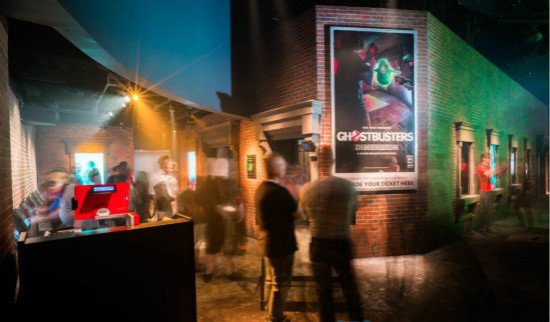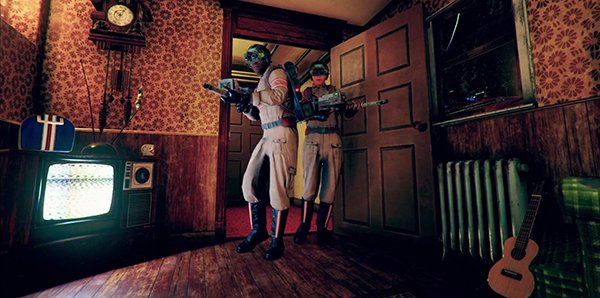For the vast majority of New York City residents, Times Square has not been the first choice for travel. However, today I had a rare visit to this place with my wife and queued in front of Madame Tussauds for the VR experience of “Ghostbuster: Dimensionâ€. Despite the cold air, the air here was still full of heat - it seemed that we were anxiously waiting for the upcoming amazing experience with us.

VOID launches VR experience at Madame Tussaud's "Ghostbusters: Dimensions"
The lined up team is filled with the atmosphere of an anime show: bearded men with exaggerated T-shirts, thrilled teenagers, and family members (including the youngest members who constantly watch the authenticity of the ghosts). At the front, the sponsor named Christopher Thornton even wore a light gray jumpsuit. After trying to stop a chaos in the party, Christopher loudly declared to the crowd: “If you feel uncomfortable, dizzy, or lose direction in the experience, reach out and touch the wall—all the walls are real. ."
Behind us, a digital sign flashes the following words: "No climbing! No running! No swimming!" "No swimming?" I turned and said to my wife, "What are these things?"
As a media designer, the company I work for is committed to creating a moving experience through the combination of media, narrative and architecture (The 9·11 Memorial Hall and the Cooper Hewitt Design Museum are all our masterpieces). In this context, I have been constantly looking for various kinds of VR experience, trying to find a revolutionary supernatural moment that can prove this technology. Unfortunately, aside from the novel appearance, most VR projects have made two basic mistakes: they have not included audience selection and human emotions in the experience.
Of course, there are still many good attempts in these VR projects, and many of these experiences are dedicated to providing a physical sense of reality under the framework of VR. HTC Vive's drawing application “Tilt Brush†produced by Google allowed me to sculpt my own work. I also turned it into a bird in VR and flew over Manhattan, waving her wings to escape the countless high-rises over the steel forest. For me, it is not a good experience. However, whether it is a real painting experience or the use of the interactive experience of the whole body—they have done a good job in realism—there's no emotional impact.
Last winter, I tried the experience of VOID (a VR system combined with high-end hardware and interactive environment). At that moment, I thought I saw the spring of VR. The experience at the time was to explore a virtual old temple. The sound of the jungle and the movie-level soundtrack made me feel a lot of exposure. VOID co-founder James Jensen (James Jensen) told me that when virtual and reality overlap in your mind, "you will suddenly feel a sense of consternation, a kind of mental instability. Can you think of it? Understand why it comes, so you can only accept it - this makes your virtual world more real." This "spiritual insecurity" can be a source of VR reality, but it does not constitute a VR experience. The first factor of the emotional kernel. In fact, for me, its existence is even irrelevant. The key is that the person who explores the virtual world together with you can connect the emotional bond between you and VR.
This year, VOID will open another VR theme park in Salt Lake City. The theme park I visited today at Madame Tussauds at Times Square is the first VOID. The first wax figure in the pavilion is Voltaire Wax made by Madame Tussauds in 1777; in the face of this heavy sense of history, experiencing VR as a symbol of the future of technology seems old, but in the history of the wax museum, There are many examples of red carpets for cutting-edge entertainment technology: From the earliest coin-operated game rooms to dynamic photos, this Madame Tussauds has witnessed the popularity of numerous cutting-edge technologies.
VOID, the full name of Vision of Infinite Dimensions, although the main business is VR, its family has been working hard to create a virtual space that exactly corresponds to the physical world; if you encounter a TV in VR, it may be A box in reality. Just like the shamans who prepare us for a psychedelic journey, the guide Christopher stressed to us that walking around and touching objects is the key to immersion: this allows our senses to fully believe in this virtual environment. The authenticity.
"You can see your friends in an experience during the meeting," said Christopher. "Everyone has their own avatar. Now there is only a male image, and we have been working hard to develop a female image."
"It's incredible!" my wife said. "I mean, this location is exactly the same as the latest Ghostbusters movie!" Even though she is a woman expert, VR has been The concept of science and technology has caused a lot of influence. As I nodded my head, the guide brought us and another couple to the experience site.

"Ghostbusters: Dimensions" VR Experience Interior
For decades, people have been building connections through virtual networks such as chat rooms and online games. However, the development of any virtual relationship can only be realized in reality. This is why today in the prevalence of internet and online courses, schools are still the main stream of education; for example, it is difficult for churches to complete evangelism on television, electronic communication technology is developed and the city continues to expand. These are all the same. reason. From the perspective of my work, the combination of the existence of others, the occurrence of sharing, and the connection of time and space, the combination of these three dimensions is enough to impress our deepest heart.
In the movie, your emotional reaction is directly related to the character: Your crying, laughing, and roaring are all realistic reverberations of characters on the screen. The VR that the real world experiences with others is more like a game played by a bunch of kids in the backyard: the recognition of your character in the group is the source of emotion. Film-level details, soundtracks, scenes, and characters are just plain old design elements to guide the experience. Really allowing you to accept this virtual world from within is always your common experience with your peers. Only by sharing with others can you develop your emotional dimension.
In VR, the importance of "existence" is self-evident, and the common "existence"--to experience the true immersive experience with others in different reality environments--will be the key to the future of VR. The reasons why both Microsoft and Facebook are relentlessly developing social VR are evident: They are all pursuing such a shared VR experience provided by VOID. In the return trip between my wife and I left the wax museum, Christopher's words still remain in my ears for a long time. He said there is everything here. Everything.